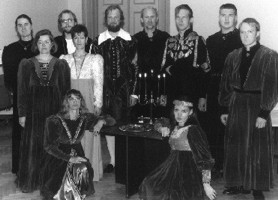Viljandi Linnakapell

Helika Gustavson (vocal); Cätlin Jaago (bagpipe); Sandra Sillamaa (bagpipe); Anu Taul (bagpipe); Neeme Punder (flutes, rauschpfeiff); Siiri Kärt (fiddle, rebec); Saale Uusma (rebec); Margus Kubo (rebab); Toivo Sõmer (lute); Marge Loik (percussion, bells, cornamuse); Anti Einpaul (recorders, shawms, cornamuse); Arno Anton (horn, trombone); Peep Heinaste (sepherd's horn)
artistic director - Neeme Punder
Viljandi Linnakapell was founded by the flute teacher Tõnu Sepp who taught at the local children's music school. At first only students and teachers were involved but in 1989 the group grow bigger and was given official status. After Tõnu Sepp left Viljandi the group was headed by its member Margus Kubo and later Peeter Klaas from Hortus Musicus. During the years 1989-1991 and again since 1998 the group is lead by Neeme Punder, the flute soloist of Hortus Musicus.
The group plays music from the Middle Ages to the Baroque. Besides performing in Estonia, it has toured in Finland, Sweden, Denmark, Germany, Lithuania and Russia.
The present programme consists of medieval songs and instrumental pieces.
Neidhart von Reuenthal (born c.1180, died after 1237) was a well-known German minnesinger who started his career at the court of Duce Otto II of Bavaria. A surprising number (68) of his poems have survived, 29 of them are Gsummer songsg and 39 Gwinter songsg. The songs are preceded by an introduction describing nature as it is in that time of the year. He uses stanza forms and rhymed verse. His music was innovative and inspired many imitators.
The French trouvere Guillaume li Vinier was active between 1190 and 1245 and was one of the most outstanding poets of the Arras region is the first half of the 13th century. He wrote love songs, ballads, nature poems and poems dedicated to the Virgin Mary.
Guillaume d'Amiens, active at the end of the 13th century, composed songs and illustrated manuscripts.
Trouvére Guillebert de Berneville was active in south-west Arras between 1250 and 1280. His verse forms are imaginative but melodies usually simple. His song GCuidoient li losengierg is written in the rortruenge form characterised by a refrain after every three to five stanzas.
Medieval music is open to interpretation as the choice of instruments and the way music is performed is left to the musician to decide. Viljandi Linnakapell offers a rich selection of rhythms and arrangements, and beside medieval instruments they use Estonian herdsman's horn and bagpipe.



